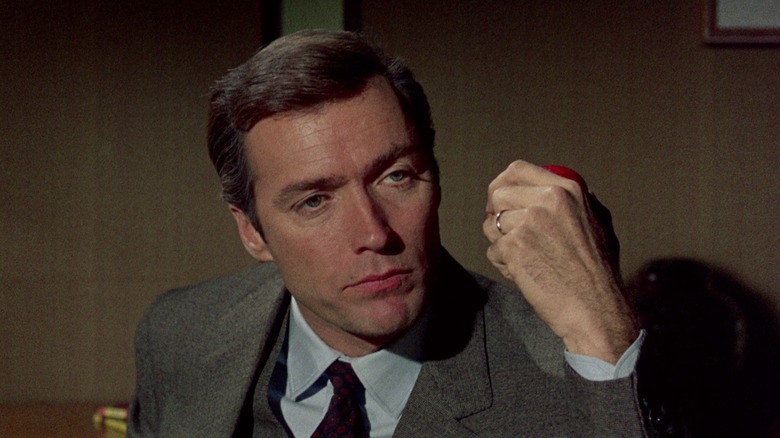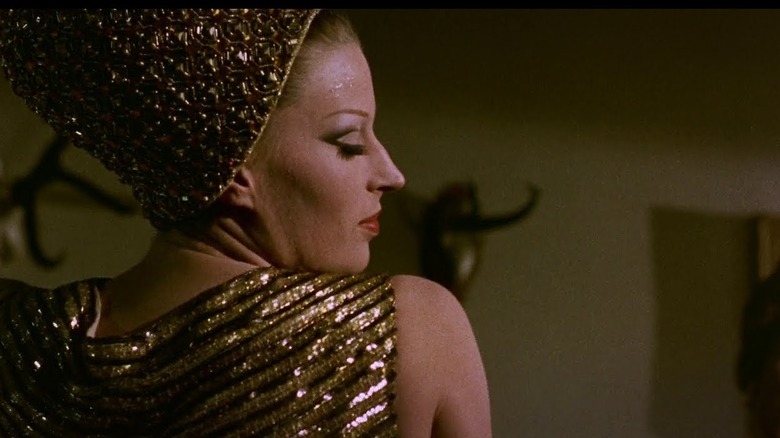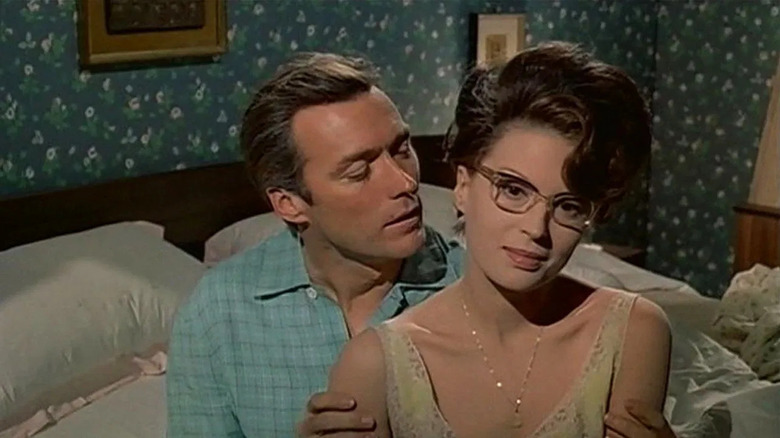After Becoming A Western Legend, Clint Eastwood Starred In A Forgotten Movie About 'Witches'
Just about every movie buff knows that Clint Eastwood shot to international fame after starring in Sergio Leone's "Dollars Trilogy," but what came next? It's a good pub quiz question because many people might leap straight to the year 1968 when a trio of hits cemented his status as one of Hollywood's top tough guys: "Hang 'Em High," "Coogan's Bluff," and "Where Eagles Dare." But tucked away in his filmography is a forgotten 1967 Italian movie called "The Witches," not to be confused with the Hammer production of the same name from the year before. Originally titled "Le streghe" in Italian, it's an offbeat anthology movie that isn't a horror film at all and has very little to do with witches, unless you squint really hard at its themes.
"The Witches" was the brainchild of legendary producer Dino De Laurentiis, who would later make an impact in Hollywood with the 1976 "King Kong" remake, John Wayne's final movie "The Shootist," the cult classic "Flash Gordon," and many others. In the mid-'60s, he envisioned a lavish anthology to showcase the beauty and talent of his wife Silvana Mangano, the acclaimed Italian actor who had worked with some of the top Neorealist directors of the time.
Mangano starred in all five segments of the film and De Laurentiis secured some big-hitters to direct: Luchino Visconti ("Death in Venice"), Pier Paolo Pasolini ("Salò, or the 120 Days of Sodom"), and Vittorio De Sica ("Bicycle Thieves") helmed three longer chapters while lesser lights Franco Rossi and Mauro Bolognini chipped in with two light-hearted skits to break things up a bit. Adding to the overall opulence of the production, Giuseppe Rotunno (who would later win an Oscar for "All That Jazz") was hired as cinematographer, while Piero Piccioni worked on music with Ennio Morricone, who was also coming off the back of his hugely successful collaborations with Leone.
In front of the camera, Mangano was supported by an array of international actors, including Annie Girardot, Francisco Rabal, Helmut Berger, and Italian comedy legend Totò. Most incongruously of all, the fifth chapter features Eastwood, who was gifted a shiny new Ferrari by De Laurentiis to say thank you for appearing in the film. "The Witches" Is an impressive package, but is it worth your time?
The four non-Clint Eastwood segments of The Witches
The opening segment by VIsconti, "The Witch Burned Alive," is the longest and strongest of the five short films in "The Witches." Mangano plays a superstar actor who arrives at a plush Austrian lodge to spend the evening with her friends. However, she provokes jealousy from the other women while the men prowl around her, trying to get her into bed. Mangano certainly looks the part in an array of fabulous outfits, and she goes big with a diva-like performance, portraying a successful woman who is regarded as a commodity by the male guests. By the time she is picked up, primped, and made up again for her departure the next day in front of the greedy eyes of the paparazzi, the story's theme of the objectification of women is very clear.
Next up is "Civic Spirit," Mauro Bolgnini's throwaway skit with Mangano as a stylish city-dweller who uses an injured motorist as an excuse to beat the Rome traffic. The punchline moves the anthology in a more comic direction in readiness for Pasolini's "The Earth Seen from the Moon." This piece is very jarring if you only know the director thanks to "Salò, or the 120 Days of Sodom," a notorious horror movie some felt went too far. Totò (Italy's answer to Charlie Chaplin) and Pasolini's lover Ninetto Davoli play Ciancicato and Baciu Miao, a down-at-heel father and son who live in a shack on the outskirts of Rome. Ciancicato's wife has just died, so the pair try to find a suitable replacement, settling on a saintly deaf-mute woman with green hair played by Mangano.
Your enjoyment of this story will depend on your tolerance for very broad Italian absurdist comedy, but it looks a treat thanks to its primary colors and offbeat locations. The piece was a re-teaming of Pasolini, Davoli, and Totò after "The Hawks and the Sparrows," and it was the comedian's final film released before he passed away. Mangano is very good again, her ethereal character being the most obviously witchy of the bunch.
The penultimate segment is "The Sicilian Belle," another brief comic sketch in which Mangano plays a daughter who tricks her dad into killing a man who offended her, triggering a gang war between rival families. It's almost a non-joke that riffs on the melodramatics of Neorealist cinema, but Mangano's knowingly histrionic performance just about sells it.
Clint Eastwood plays against type in The Witches
Finally, we come to Clint Eastwood in "An Evening like the Others," and it's a role that couldn't be more different from the "Man With No Name" persona that made him famous. Clint plays a boring husband who would rather go to sleep when he gets home than romance his wife (Mangano), who is disappointed by the lack of excitement in their relationship. She still has burning passions behind her buttoned-up appearance and horn-rimmed spectacles, and she vents her frustration through elaborate daydreams that reveal her racy fantasies of wild and ecstatic love.
It's a solid two-hander for Eastwood and Mangano, and they make a fetching pair, although there isn't a huge amount of chemistry between them. Nevertheless, it does give Eastwood a chance to show a lighter side to his screen persona (something that often feels a bit stilted when he attempts comedy in his Hollywood movies). The segment doesn't really amount to much, and it feels like another excuse to dress up Mangano in some more outrageous costumes in the dream sequences before the credits roll. Amusingly, one of her fantasies involves a roster of comic book characters including Batman and Diabolik, the popular Italian anti-hero who would get his own star vehicle in De Laurentiis's next production, "Danger: Diabolik."
"The Witches" is a forgotten curio in Eastwood's filmography, largely down to the fact that United Artists bought the U.S. distribution rights and promptly buried it, concerned that his milquetoast role would harm his lucrative tough guy status after the roaring success of the Dollars Trilogy. You can kind of see the studio's point; it would have no doubt confused audiences to see Eastwood in an Italian arthouse anthology film with a title that may have misled people into expecting a horror movie. From a modern viewpoint, the film's battle-of-the-sexes theme are pretty dated, and it isn't strong enough to warrant viewing unless you're an Eastwood completist or a major Italian movie buff. If you are a fan of swinging '60s style, however, you'll surely fill your boots with the riot of groovy set designs and fashion on display.


